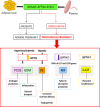Leptin action in normal and pathological pregnancies
- PMID: 29160594
- PMCID: PMC5783877
- DOI: 10.1111/jcmm.13369
Leptin action in normal and pathological pregnancies
Abstract
Leptin is now considered an important signalling molecule of the reproductive system, as it regulates the production of gonadotrophins, the blastocyst formation and implantation, the normal placentation, as well as the foeto-placental communication. Leptin is a peptide hormone secreted mainly by adipose tissue, and the placenta is the second leptin-producing tissue in humans. Placental leptin is an important cytokine which regulates placental functions in an autocrine or paracrine manner. Leptin seems to play a crucial role during the first stages of pregnancy as it modulates critical processes such as proliferation, protein synthesis, invasion and apoptosis in placental cells. Furthermore, deregulation of leptin levels has been correlated with the pathogenesis of various disorders associated with reproduction and gestation, including polycystic ovary syndrome, recurrent miscarriage, gestational diabetes mellitus, pre-eclampsia and intrauterine growth restriction. Due to the relevant incidence of the mentioned diseases and the importance of leptin, we decided to review the latest information available about leptin action in normal and pathological pregnancies to support the idea of leptin as an important factor and/or predictor of diverse disorders associated with reproduction and pregnancy.
Keywords: gestational diabetes; growth restriction; leptin; placenta; polycystic ovary syndrome; pre-eclampsia; recurrent miscarriage; reproduction.
© 2017 The Authors. Journal of Cellular and Molecular Medicine published by John Wiley & Sons Ltd and Foundation for Cellular and Molecular Medicine.
Figures


References
-
- El Husseny MW, Mamdouh M, Shaban S, et al Adipokines: potential therapeutic targets for vascular dysfunction in type II diabetes mellitus and obesity. J Diabetes Res. 2017; 1–11. https://doi.org/10.1155/2017/8095926. - DOI - PMC - PubMed
-
- Pérez‐Pérez A, Sánchez‐Jiménez F, Maymó J, et al Role of leptin in female reproduction. Clin Chem Lab Med. 2015; 53: 15–28. - PubMed
-
- Lekva T, Roland MCP, Michelsen AE, et al Large reduction in adiponectin during pregnancy is associated with large for gestational age newborns. J Clin Endocrinol Metab. 2017; 102: 2552–9. - PubMed
Publication types
MeSH terms
Substances
LinkOut - more resources
Full Text Sources
Other Literature Sources
Medical

